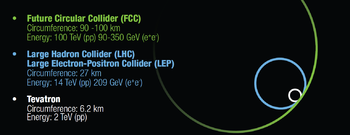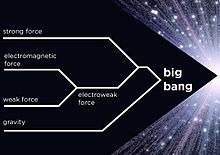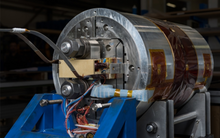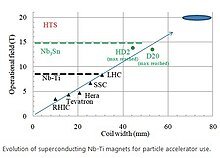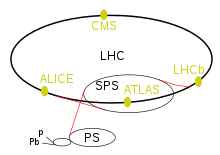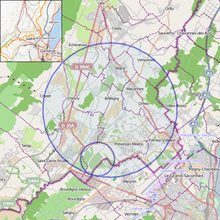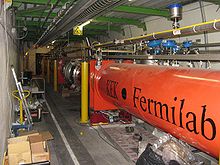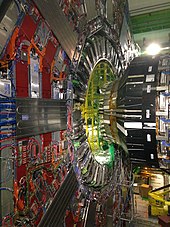From Wikipedia, the free encyclopedia
The Large Hadron Collider (LHC) is the world's largest and highest-energy particle collider. It was built by the European Organization for Nuclear Research
(CERN) between 1998 and 2008 in collaboration with over 10,000
scientists and hundreds of universities and laboratories, as well as
more than 100 countries. It lies in a tunnel 27 kilometres (17 mi) in circumference and as deep as 175 metres (574 ft) beneath the France–Switzerland border near Geneva.
The first collisions were achieved in 2010 at an energy of 3.5 teraelectronvolts (TeV) per beam, about four times the previous world record. After upgrades it reached 6.5 TeV per beam (13 TeV total collision energy, the present world record). At the end of 2018, it was shut down for three years for further upgrades.
The collider has four crossing points where the accelerated particles collide. Seven detectors,
each designed to detect different phenomena, are positioned around the
crossing points. The LHC primarily collides proton beams, but it can
also accelerate beams of heavy ions: lead–lead collisions and proton–lead collisions are typically performed for one month a year.
The LHC's goal is to allow physicists to test the predictions of different theories of particle physics, including measuring the properties of the Higgs boson searching for the large family of new particles predicted by supersymmetric theories, and other unresolved questions in particle physics.
Background
The term hadron refers to subatomic composite particles composed of quarks held together by the strong force (analogous to the way that atoms and molecules are held together by the electromagnetic force). The best-known hadrons are the baryons such as protons and neutrons; hadrons also include mesons such as the pion and kaon, which were discovered during cosmic ray experiments in the late 1940s and early 1950s.
A collider is a type of a particle accelerator which brings two opposing particle beams together such that the particles collide. In particle physics, colliders, though harder to construct, are a powerful research tool because they reach a much higher center of mass energy than fixed target setups. Analysis of the byproducts of these collisions gives scientists good evidence of the structure of the subatomic
world and the laws of nature governing it. Many of these byproducts are
produced only by high-energy collisions, and they decay after very
short periods of time. Thus many of them are hard or nearly impossible
to study in other ways.
Purpose
Many physicists hope that the Large Hadron Collider will help answer some of the fundamental open questions in physics, which concern the basic laws governing the interactions and forces among the elementary objects, the deep structure of space and time, and in particular the interrelation between quantum mechanics and general relativity.
Data are also needed from high-energy particle
experiments to suggest which versions of current scientific models are
more likely to be correct – in particular to choose between the Standard Model and Higgsless model and to validate their predictions and allow further theoretical development.
Issues explored by LHC collisions include:
Other open questions that may be explored using high-energy particle collisions:
Design
The
collider is contained in a circular tunnel, with a circumference of 26.7
kilometres (16.6 mi), at a depth ranging from 50 to 175 metres (164 to
574 ft) underground. The variation in depth was deliberate, to reduce
the amount of tunnel that lies under the Jura Mountains
to avoid having to excavate a vertical access shaft there. A tunnel was
chosen to avoid having to purchase expensive land on the surface, which
would also have an impact on the landscape and to take advantage of the
shielding against background radiation that the earth's crust provides.
Map of the Large Hadron Collider at CERN
The 3.8-metre (12 ft) wide concrete-lined tunnel, constructed between 1983 and 1988, was formerly used to house the Large Electron–Positron Collider.
The tunnel crosses the border between Switzerland and France at four
points, with most of it in France. Surface buildings hold ancillary
equipment such as compressors, ventilation equipment, control
electronics and refrigeration plants.
Superconducting
quadrupole electromagnets are used to direct the beams to four intersection points, where interactions between accelerated protons will take place.
The collider tunnel contains two adjacent parallel beamlines (or beam pipes)
each containing a beam, which travel in opposite directions around the
ring. The beams intersect at four points around the ring, which is where
the particle collisions take place. Some 1,232 dipole magnets keep the beams on their circular path, while an additional 392 quadrupole magnets
are used to keep the beams focused, with stronger quadrupole magnets
close to the intersection points in order to maximize the chances of
interaction where the two beams cross. Magnets of higher multipole orders are used to correct smaller imperfections in the field geometry. In total, about 10,000 superconducting magnets are installed, with the dipole magnets having a mass of over 27 tonnes. Approximately 96 tonnes of superfluid helium-4 is needed to keep the magnets, made of copper-clad niobium-titanium, at their operating temperature of 1.9 K (−271.25 °C), making the LHC the largest cryogenic facility in the world at liquid helium temperature. LHC uses 470 tonnes of Nb–Ti superconductor.
During LHC operations, the CERN site draws roughly 200 MW of electrical power from the French electrical grid,
which, for comparison, is about one-third the energy consumption of the
city of Geneva; the LHC accelerator and detectors draw about 120 MW
thereof. Each day of its operation generates 140 terabytes of data.
When running an energy of 6.5 TeV per proton, once or twice a day, as the protons are accelerated from 450 GeV to 6.5 TeV, the field of the superconducting dipole magnets is increased from 0.54 to 7.7 teslas (T). The protons each have an energy of 6.5 TeV, giving a total collision energy of 13 TeV. At this energy, the protons have a Lorentz factor of about 6,930 and move at about 0.999999990 c, or about 3.1 m/s (11 km/h) slower than the speed of light (c). It takes less than 90 microseconds (μs) for a proton to travel 26.7 km around the main ring. This results in 11,245 revolutions
per second for protons whether the particles are at low or high energy
in the main ring, since the speed difference between these energies is
beyond the fifth decimal.
Rather than having continuous beams, the protons are bunched together, into up to 2,808 bunches, with 115 billion protons in each bunch so that interactions between the two beams take place at discrete intervals, mainly 25 nanoseconds (ns) apart, providing a bunch collision rate of 40 MHz. It was operated with fewer bunches in the first years. The design luminosity of the LHC is 1034 cm−2s−1, which was first reached in June 2016. By 2017, twice this value was achieved.
The LHC protons originate from the small red hydrogen tank.
Before being injected into the main accelerator, the particles are
prepared by a series of systems that successively increase their energy.
The first system is the linear particle accelerator Linac4 generating 160 MeV negative hydrogen ions (H− ions), which feeds the Proton Synchrotron Booster
(PSB). There, both electrons are stripped from the hydrogen ions
leaving only the nucleus containing one proton. Protons are then
accelerated to 2 GeV and injected into the Proton Synchrotron (PS), where they are accelerated to 26 GeV. Finally, the Super Proton Synchrotron
(SPS) is used to increase their energy further to 450 GeV before they
are at last injected (over a period of several minutes) into the main
ring. Here, the proton bunches are accumulated, accelerated (over a
period of 20 minutes) to their peak energy, and finally circulated for 5 to 24 hours while collisions occur at the four intersection points.
The LHC physics programme is mainly based on proton–proton
collisions. However, during shorter running periods, typically one month
per year, heavy-ion collisions are included in the programme. While
lighter ions are considered as well, the baseline scheme deals with lead ions (see A Large Ion Collider Experiment). The lead ions are first accelerated by the linear accelerator LINAC 3, and the Low Energy Ion Ring
(LEIR) is used as an ion storage and cooler unit. The ions are then
further accelerated by the PS and SPS before being injected into LHC
ring, where they reach an energy of 2.3 TeV per nucleon (or 522 TeV per ion), higher than the energies reached by the Relativistic Heavy Ion Collider. The aim of the heavy-ion programme is to investigate quark–gluon plasma, which existed in the early universe.
Detectors
Eight detectors have been constructed at the LHC, located underground
in large caverns excavated at the LHC's intersection points. Two of
them, the ATLAS experiment and the Compact Muon Solenoid (CMS), are large general-purpose particle detectors. ALICE and LHCb have more specialized roles and the last four, TOTEM, MoEDAL, LHCf, and FASER
are much smaller and are for very specialized research. The ATLAS and
CMS experiments discovered the Higgs boson, which is strong evidence
that the Standard Model has the correct mechanism of giving mass to
elementary particles.
Computing and analysis facilities
Data produced by LHC, as well as LHC-related simulation, were estimated at approximately 15 petabytes per year (max throughput while running is not stated)—a major challenge in its own right at the time.
The LHC Computing Grid
was constructed as part of the LHC design, to handle the massive
amounts of data expected for its collisions. It is an international
collaborative project that consists of a grid-based computer network infrastructure initially connecting 140 computing centres in 35 countries (over 170 in 36 countries as of 2012). It was designed by CERN to handle the significant volume of data produced by LHC experiments, incorporating both private fibre optic cable links and existing high-speed portions of the public Internet to enable data transfer from CERN to academic institutions around the world. The Open Science Grid
is used as the primary infrastructure in the United States, and also as
part of an interoperable federation with the LHC Computing Grid.
The distributed computing project LHC@home was started to support the construction and calibration of the LHC. The project uses the BOINC platform, enabling anybody with an Internet connection and a computer running Mac OS X, Windows or Linux
to use their computer's idle time to simulate how particles will travel
in the beam pipes. With this information, the scientists are able to
determine how the magnets should be calibrated to gain the most stable
"orbit" of the beams in the ring.
In August 2011, a second application (Test4Theory) went live which
performs simulations against which to compare actual test data, to
determine confidence levels of the results.
By 2012, data from over 6 quadrillion (6×1015) LHC proton–proton collisions had been analysed, LHC collision data was being produced at approximately 25 petabytes per year, and the LHC Computing Grid had become the world's largest computing grid in 2012, comprising over 170 computing facilities in a worldwide network across 36 countries.
Operational history
The LHC first went live on 10 September 2008, but initial testing was delayed for 14 months from 19 September 2008 to 20 November 2009, following a magnet quench incident that caused extensive damage to over 50 superconducting magnets, their mountings, and the vacuum pipe.
During its first run (2010–2013), the LHC collided two opposing particle beams of either protons at up to 4 teraelectronvolts (4 TeV or 0.64 microjoules), or lead nuclei (574 TeV per nucleus, or 2.76 TeV per nucleon). Its first run discoveries included the long-sought Higgs boson, several composite particles (hadrons) like the χb (3P) bottomonium state, the first creation of a quark–gluon plasma, and the first observations of the very rare decay of the Bs meson into two muons (Bs0 → μ+μ−), which challenged the validity of existing models of supersymmetry.
Construction
Operational challenges
The
size of the LHC constitutes an exceptional engineering challenge with
unique operational issues on account of the amount of energy stored in
the magnets and the beams. While operating, the total energy stored in the magnets is 10 GJ (2,400 kilograms of TNT) and the total energy carried by the two beams reaches 724 MJ (173 kilograms of TNT).
Loss of only one ten-millionth part (10−7) of the beam is sufficient to quench a superconducting magnet, while each of the two beam dumps
must absorb 362 MJ (87 kilograms of TNT). These energies are carried by
very little matter: under nominal operating conditions (2,808 bunches
per beam, 1.15×1011 protons per bunch), the beam pipes contain 1.0×10−9 gram of hydrogen, which, in standard conditions for temperature and pressure, would fill the volume of one grain of fine sand.
Cost
With a budget of €7.5 billion (approx. $9bn or £6.19bn as of June 2010), the LHC is one of the most expensive scientific instruments ever built. The total cost of the project is expected to be of the order of 4.6bn Swiss francs (SFr) (approx. $4.4bn, €3.1bn, or £2.8bn as of January 2010) for the accelerator and 1.16bn (SFr) (approx. $1.1bn, €0.8bn, or £0.7bn as of January 2010) for the CERN contribution to the experiments.
The construction of LHC was approved in 1995 with a budget of SFr
2.6bn, with another SFr 210M toward the experiments. However, cost
overruns, estimated in a major review in 2001 at around SFr 480M for the
accelerator, and SFr 50M for the experiments, along with a reduction in
CERN's budget, pushed the completion date from 2005 to April 2007.
The superconducting magnets were responsible for SFr 180M of the cost
increase. There were also further costs and delays owing to engineering
difficulties encountered while building the cavern for the Compact Muon Solenoid,
and also due to magnet supports which were insufficiently strongly
designed and failed their initial testing (2007) and damage from a magnet quench and liquid helium escape (inaugural testing, 2008) (see: Construction accidents and delays). Because electricity costs are lower during the summer, the LHC normally does not operate over the winter months,
although exceptions over the 2009/10 and 2012/2013 winters were made to
make up for the 2008 start-up delays and to improve precision of
measurements of the new particle discovered in 2012, respectively.
Construction accidents and delays
- On 25 October 2005, José Pereira Lages, a technician, was killed in the LHC when a switchgear that was being transported fell on top of him.
- On 27 March 2007, a cryogenic magnet support designed and provided by Fermilab and KEK
broke during an initial pressure test involving one of the LHC's inner
triplet (focusing quadrupole) magnet assemblies. No one was injured.
Fermilab director Pier Oddone stated "In this case we are dumbfounded
that we missed some very simple balance of forces". The fault had been
present in the original design, and remained during four engineering
reviews over the following years.
Analysis revealed that its design, made as thin as possible for better
insulation, was not strong enough to withstand the forces generated
during pressure testing. Details are available in a statement from
Fermilab, with which CERN is in agreement.
Repairing the broken magnet and reinforcing the eight identical
assemblies used by LHC delayed the start-up date, then planned for
November 2007.
- On 19 September 2008, during initial testing, a faulty electrical connection led to a magnet quench (the sudden loss of a superconducting magnet's superconducting ability owing to warming or electric field effects). Six tonnes of supercooled liquid helium—used
to cool the magnets—escaped, with sufficient force to break 10-ton
magnets nearby from their mountings, and caused considerable damage and
contamination of the vacuum tube. Repairs and safety checks caused a
delay of around 14 months.
- Two vacuum leaks were found in July 2009, and the start of operations was further postponed to mid-November 2009.
Initial lower magnet currents
In both of its runs (2010 to 2012 and 2015), the LHC was initially
run at energies below its planned operating energy, and ramped up to
just 2 x 4 TeV energy on its first run and 2 x 6.5 TeV on its second
run, below the design energy of 2 x 7 TeV. This is because massive
superconducting magnets require considerable magnet training to handle the high currents involved without losing their superconducting ability,
and the high currents are necessary to allow a high proton energy. The
"training" process involves repeatedly running the magnets with lower
currents to provoke any quenches or minute movements that may result. It
also takes time to cool down magnets to their operating temperature of
around 1.9 K (close to absolute zero).
Over time the magnet "beds in" and ceases to quench at these lesser
currents and can handle the full design current without quenching; CERN
media describe the magnets as "shaking out" the unavoidable tiny
manufacturing imperfections in their crystals and positions that had
initially impaired their ability to handle their planned currents. The
magnets, over time and with training, gradually become able to handle
their full planned currents without quenching.
Inaugural tests (2008)
The first beam was circulated through the collider on the morning of 10 September 2008. CERN
successfully fired the protons around the tunnel in stages, three
kilometres at a time. The particles were fired in a clockwise direction
into the accelerator and successfully steered around it at 10:28 local
time.
The LHC successfully completed its major test: after a series of trial
runs, two white dots flashed on a computer screen showing the protons
travelled the full length of the collider. It took less than one hour to
guide the stream of particles around its inaugural circuit.
CERN next successfully sent a beam of protons in an anticlockwise
direction, taking slightly longer at one and a half hours owing to a
problem with the cryogenics, with the full circuit being completed at 14:59.
Quench incident
On 19 September 2008, a magnet quench occurred in about 100 bending magnets in sectors 3 and 4, where an electrical fault led to a loss of approximately six tonnes of liquid helium (the magnets' cryogenic coolant), which was vented into the tunnel. The escaping vapour expanded with explosive force, damaging a total of 53 superconducting magnets and their mountings, and contaminating the vacuum pipe, which also lost vacuum conditions.
Shortly after the incident, CERN reported that the most likely cause of the problem was a faulty electrical connection
between two magnets, and that – owing to the time needed to warm up the
affected sectors and then cool them back down to operating
temperature – it would take at least two months to fix. CERN released an interim technical report and preliminary analysis of the incident on 15 and 16 October 2008 respectively, and a more detailed report on 5 December 2008.
The analysis of the incident by CERN confirmed that an electrical fault
had indeed been the cause. The faulty electrical connection had led
(correctly) to a failsafe power abort of the electrical systems powering the superconducting magnets, but had also caused an electric arc
(or discharge) which damaged the integrity of the supercooled helium's
enclosure and vacuum insulation, causing the coolant's temperature and
pressure to rapidly rise beyond the ability of the safety systems to
contain it, and leading to a temperature rise of about 100 degrees Celsius in some of the affected magnets. Energy stored in the superconducting magnets and electrical noise induced in other quench detectors also played a role in the rapid heating. Around two tonnes
of liquid helium escaped explosively before detectors triggered an
emergency stop, and a further four tonnes leaked at lower pressure in
the aftermath. A total of 53 magnets were damaged in the incident and were repaired or replaced during the winter shutdown. This accident was thoroughly discussed in a 22 February 2010 Superconductor Science and Technology article by CERN physicist Lucio Rossi.
In the original schedule for LHC commissioning, the first "modest" high-energy collisions at a centre-of-mass
energy of 900 GeV were expected to take place before the end of
September 2008, and the LHC was expected to be operating at 10 TeV by
the end of 2008. However, owing to the delay caused by the incident, the collider was not operational until November 2009.
Despite the delay, LHC was officially inaugurated on 21 October 2008,
in the presence of political leaders, science ministers from CERN's 20
Member States, CERN officials, and members of the worldwide scientific
community.
Most of 2009 was spent on repairs and reviews from the damage
caused by the quench incident, along with two further vacuum leaks
identified in July 2009; this pushed the start of operations to November
of that year.
Run 1: first operational run (2009–2013)
On 20 November 2009, low-energy beams circulated in the tunnel for
the first time since the incident, and shortly after, on 30 November,
the LHC achieved 1.18 TeV per beam to become the world's highest-energy
particle accelerator, beating the Tevatron's previous record of 0.98 TeV per beam held for eight years.
The early part of 2010 saw the continued ramp-up of beam in
energies and early physics experiments towards 3.5 TeV per beam and on
30 March 2010, LHC set a new record for high-energy collisions by
colliding proton beams at a combined energy level of 7 TeV. The attempt
was the third that day, after two unsuccessful attempts in which the
protons had to be "dumped" from the collider and new beams had to be
injected. This also marked the start of the main research programme.
The first proton run ended on 4 November 2010. A run with lead ions started on 8 November 2010, and ended on 6 December 2010, allowing the ALICE experiment to study matter under extreme conditions similar to those shortly after the Big Bang.
CERN originally planned that the LHC would run through to the end
of 2012, with a short break at the end of 2011 to allow for an increase
in beam energy from 3.5 to 4 TeV per beam.
At the end of 2012, the LHC was planned to get shut down until around
2015 to allow upgrade to a planned beam energy of 7 TeV per beam. In late 2012, in light of the July 2012 discovery of the Higgs boson, the shutdown was postponed for some weeks into early 2013, to allow additional data to be obtained before shutdown.
Long Shutdown 1 (2013–2015)

The LHC was shut down on 13 February 2013 for its 2-year upgrade
called Long Shutdown 1 (LS1), which was to touch on many aspects of the
LHC: enabling collisions at 14 TeV, enhancing its detectors and
pre-accelerators (the Proton Synchrotron and Super Proton Synchrotron),
as well as replacing its ventilation system and 100 km (62 mi) of
cabling impaired by high-energy collisions from its first run.
The upgraded collider began its long start-up and testing process in
June 2014, with the Proton Synchrotron Booster starting on 2 June 2014,
the final interconnection between magnets completing and the Proton
Synchrotron circulating particles on 18 June 2014, and the first section
of the main LHC supermagnet system reaching operating temperature of
1.9 K (−271.25 °C), a few days later. Due to the slow progress with "training"
the superconducting magnets, it was decided to start the second run
with a lower energy of 6.5 TeV per beam, corresponding to a current of
11,000 amperes.
The first of the main LHC magnets were reported to have been
successfully trained by 9 December 2014, while training the other magnet
sectors was finished in March 2015.
Run 2: second operational run (2015–2018)
On
5 April 2015, the LHC restarted after a two-year break, during which
the electrical connectors between the bending magnets were upgraded to
safely handle the current required for 7 TeV per beam (14 TeV). However, the bending magnets were only trained to handle up to 6.5 TeV per beam (13 TeV total), which became the operating energy for 2015 to 2018. The energy was first reached on 10 April 2015. The upgrades culminated in colliding protons together with a combined energy of 13 TeV. On 3 June 2015, the LHC started delivering physics data after almost two years offline.
In the following months, it was used for proton–proton collisions,
while in November, the machine switched to collisions of lead ions and
in December, the usual winter shutdown started.
In 2016, the machine operators focused on increasing the
luminosity for proton–proton collisions. The design value was first
reached 29 June, and further improvements increased the collision rate to 40% above the design value.
The total number of collisions in 2016 exceeded the number from Run 1 –
at a higher energy per collision. The proton–proton run was followed by
four weeks of proton–lead collisions.
In 2017, the luminosity was increased further and reached twice
the design value. The total number of collisions was higher than in 2016
as well.
The 2018 physics run began on 17 April and stopped on 3 December, including four weeks of lead–lead collisions.
Long Shutdown 2 (2018–2022)
Long
Shutdown 2 (LS2) started on 10 December 2018. The LHC and the whole
CERN accelerator complex was maintained and upgraded. The goal of the
upgrades was to implement the High Luminosity Large Hadron Collider
(HL-LHC) project that will increase the luminosity by a factor of 10.
LS2 ended in April 2022. The Long Shutdown 3 (LS3) in the 2020s will
take place before the HL-LHC project is done.
Run 3: third operational round (2022)
LHC became operational again on 22 April 2022 with a new maximum beam energy of 6.8 TeV, which was first achieved on 25 April. This round is expected to continue until 2026.
Timeline of operations
| Date
|
Event
|
| 10 Sep 2008
|
CERN successfully fired the first protons around the entire tunnel circuit in stages.
|
| 19 Sep 2008
|
Magnetic quench occurred in about 100 bending magnets in sectors 3 and 4, causing a loss of approximately 6 tonnes of liquid helium.
|
| 30 Sep 2008
|
First "modest" high-energy collisions planned but postponed due to accident.
|
| 16 Oct 2008
|
CERN released a preliminary analysis of the accident.
|
| 21 Oct 2008
|
Official inauguration.
|
| 5 Dec 2008
|
CERN released detailed analysis.
|
| 20 Nov 2009
|
Low-energy beams circulated in the tunnel for the first time since the accident.
|
| 23 Nov 2009
|
First particle collisions in all four detectors at 450 GeV.
|
| 30 Nov 2009
|
LHC becomes the world's highest-energy particle accelerator achieving 1.18 TeV per beam, beating the Tevatron's previous record of 0.98 TeV per beam held for eight years.
|
| 15 Dec 2009
|
First scientific results, covering 284 collisions in the ALICE detector.
|
| 30 Mar 2010
|
The two beams collided at 7 TeV (3.5 TeV per beam) in the LHC at 13:06 CEST, marking the start of the LHC research programme.
|
| 8 Nov 2010
|
Start of the first run with lead ions.
|
| 6 Dec 2010
|
End of the run with lead ions. Shutdown until early 2011.
|
| 13 Mar 2011
|
Beginning of the 2011 run with proton beams.
|
| 21 Apr 2011
|
LHC becomes the world's highest-luminosity hadron accelerator achieving a peak luminosity of 4.67·1032 cm−2s−1, beating the Tevatron's previous record of 4·1032 cm−2s−1 held for one year.
|
| 24 May 2011
|
ALICE reports that a Quark–gluon plasma has been achieved with earlier lead collisions.
|
| 17 Jun 2011
|
The high-luminosity experiments ATLAS and CMS reach 1 fb−1 of collected data.
|
| 14 Oct 2011
|
LHCb reaches 1 fb−1 of collected data.
|
| 23 Oct 2011
|
The high-luminosity experiments ATLAS and CMS reach 5 fb−1 of collected data.
|
| Nov 2011
|
Second run with lead ions.
|
| 22 Dec 2011
|
First new composite particle discovery, the χb (3P) bottomonium meson, observed with proton–proton collisions in 2011.
|
| 5 Apr 2012
|
First collisions with stable beams in 2012 after the winter
shutdown. The energy is increased to 4 TeV per beam (8 TeV in
collisions).
|
| 4 Jul 2012
|
First new elementary particle discovery, a new boson observed that is "consistent with" the theorized Higgs boson. (This has now been confirmed as the Higgs boson itself.)
|
| 8 Nov 2012
|
First observation of the very rare decay of the Bs meson into two muons (Bs0 → μ+μ−), a major test of supersymmetry theories, shows results at 3.5 sigma that match the Standard Model rather than many of its super-symmetrical variants.
|
| 20 Jan 2013
|
Start of the first run colliding protons with lead ions.
|
| 11 Feb 2013
|
End of the first run colliding protons with lead ions.
|
| 14 Feb 2013
|
Beginning of the first long shutdown to prepare the collider for a higher energy and luminosity.
|
| Long Shutdown 1
|
| 7 Mar 2015
|
Injection tests for Run 2 send protons towards LHCb & ALICE
|
| 5 Apr 2015
|
Both beams circulated in the collider. Four days later, a new record energy of 6.5 TeV per proton was achieved.
|
| 20 May 2015
|
Protons collided in the LHC at the record-breaking collision energy of 13 TeV.
|
| 3 Jun 2015
|
Start of delivering the physics data after almost two years offline for recommissioning.
|
| 4 Nov 2015
|
End of proton collisions in 2015, start of preparations for ion collisions.
|
| Nov 2015
|
Ion collisions at a record-breaking energy of more than 1 PeV (1015 eV)
|
| 13 Dec 2015
|
End of ion collisions in 2015
|
| 23 Apr 2016
|
Data-taking in 2016 begins
|
| 29 June 2016
|
The LHC achieves a luminosity of 1.0 · 1034 cm−2s−1, its design value. Further improvements over the year increased the luminosity to 40% above the design value.
|
| 26 Oct 2016
|
End of 2016 proton–proton collisions
|
| 10 Nov 2016
|
Beginning of 2016 proton–lead collisions
|
| 3 Dec 2016
|
End of 2016 proton–lead collisions
|
| 24 May 2017
|
Start of 2017 proton–proton collisions. During 2017, the luminosity increased to twice its design value.
|
| 10 Nov 2017
|
End of regular 2017 proton–proton collision mode.
|
| 17 Apr 2018
|
Start of 2018 proton–proton collisions.
|
| 12 Nov 2018
|
End of 2018 proton operations at CERN.
|
| 3 Dec 2018
|
End of 2018 lead-ion run.
|
| 10 Dec 2018
|
End of 2018 physics operation and start of Long Shutdown 2.
|
| Long Shutdown 2
|
| 22 Apr 2022
|
LHC becomes operational again.
|
Findings and discoveries
An initial focus of research was to investigate the possible existence of the Higgs boson, a key part of the Standard Model
of physics which was predicted by theory, but had not yet been observed
before due to its high mass and elusive nature. CERN scientists
estimated that, if the Standard Model was correct, the LHC would produce
several Higgs bosons every minute, allowing physicists to finally
confirm or disprove the Higgs boson's existence. In addition, the LHC
allowed the search for supersymmetric particles and other hypothetical particles as possible unknown areas of physics. Some extensions of the Standard Model predict additional particles, such as the heavy W' and Z' gauge bosons, which are also estimated to be within reach of the LHC to discover.
First run (data taken 2009–2013)
The first physics results from the LHC, involving 284 collisions which took place in the ALICE detector, were reported on 15 December 2009.
The results of the first proton–proton collisions at energies higher
than Fermilab's Tevatron proton–antiproton collisions were published by
the CMS collaboration in early February 2010, yielding greater-than-predicted charged-hadron production.
After the first year of data collection, the LHC experimental
collaborations started to release their preliminary results concerning
searches for new physics beyond the Standard Model in proton–proton
collisions.
No evidence of new particles was detected in the 2010 data. As a
result, bounds were set on the allowed parameter space of various
extensions of the Standard Model, such as models with large extra dimensions, constrained versions of the Minimal Supersymmetric Standard Model, and others.
On 24 May 2011, it was reported that quark–gluon plasma (the densest matter thought to exist besides black holes) had been created in the LHC.
Between July and August 2011, results of searches for the Higgs boson
and for exotic particles, based on the data collected during the first
half of the 2011 run, were presented in conferences in Grenoble and Mumbai.
In the latter conference, it was reported that, despite hints of a
Higgs signal in earlier data, ATLAS and CMS exclude with 95% confidence
level (using the CLs
method) the existence of a Higgs boson with the properties predicted by
the Standard Model over most of the mass region between 145 and 466
GeV.
The searches for new particles did not yield signals either, allowing
to further constrain the parameter space of various extensions of the
Standard Model, including its supersymmetric extensions.
On 13 December 2011, CERN reported that the Standard Model Higgs
boson, if it exists, is most likely to have a mass constrained to the
range 115–130 GeV.
Both the CMS and ATLAS detectors have also shown intensity peaks in the
124–125 GeV range, consistent with either background noise or the
observation of the Higgs boson.
On 22 December 2011, it was reported that a new composite particle had been observed, the χb (3P) bottomonium state.
On 4 July 2012, both the CMS and ATLAS teams announced the
discovery of a boson in the mass region around 125–126 GeV, with a
statistical significance at the level of 5 sigma
each. This meets the formal level required to announce a new particle.
The observed properties were consistent with the Higgs boson, but
scientists were cautious as to whether it is formally identified as
actually being the Higgs boson, pending further analysis. On 14 March 2013, CERN announced confirmation that the observed particle was indeed the predicted Higgs Boson.
On 8 November 2012, the LHCb team reported on an experiment seen as a "golden" test of supersymmetry theories in physics, by measuring the very rare decay of the  meson into two muons (
meson into two muons ( ). The results, which match those predicted by the non-supersymmetrical Standard Model
rather than the predictions of many branches of supersymmetry, show the
decays are less common than some forms of supersymmetry predict, though
could still match the predictions of other versions of supersymmetry
theory. The results as initially drafted are stated to be short of proof
but at a relatively high 3.5 sigma level of significance. The result was later confirmed by the CMS collaboration.
). The results, which match those predicted by the non-supersymmetrical Standard Model
rather than the predictions of many branches of supersymmetry, show the
decays are less common than some forms of supersymmetry predict, though
could still match the predictions of other versions of supersymmetry
theory. The results as initially drafted are stated to be short of proof
but at a relatively high 3.5 sigma level of significance. The result was later confirmed by the CMS collaboration.
In August 2013, the LHCb team revealed an anomaly in the angular distribution of B meson
decay products which could not be predicted by the Standard Model; this
anomaly had a statistical certainty of 4.5 sigma, just short of the 5
sigma needed to be officially recognized as a discovery. It is unknown
what the cause of this anomaly would be, although the Z' boson has been suggested as a possible candidate.
On 19 November 2014, the LHCb experiment announced the discovery of two new heavy subatomic particles,
Ξ′−
b and
Ξ∗−
b.
Both of them are baryons that are composed of one bottom, one down, and
one strange quark. They are excited states of the bottom Xi baryon.
The LHCb collaboration has observed multiple exotic hadrons, possibly pentaquarks or tetraquarks, in the Run 1 data.
On 4 April 2014, the collaboration confirmed the existence of the tetraquark candidate Z(4430) with a significance of over 13.9 sigma. On 13 July 2015, results consistent with pentaquark states in the decay of bottom Lambda baryons (Λ0
b) were reported.
On 28 June 2016, the collaboration announced four tetraquark-like
particles decaying into a J/ψ and a φ meson, only one of which was well
established before (X(4274), X(4500) and X(4700) and X(4140)).
In December 2016, ATLAS presented a measurement of the W boson mass, researching the precision of analyses done at the Tevatron.
Second run (2015–2018)
At
the conference EPS-HEP 2015 in July, the collaborations presented first
cross-section measurements of several particles at the higher collision
energy.
On 15 December 2015, the ATLAS and CMS experiments both reported a number of preliminary results for Higgs physics, supersymmetry (SUSY) searches and exotics searches using 13 TeV proton collision data. Both experiments saw a moderate excess around 750 GeV in the two-photon invariant mass spectrum, but the experiments did not confirm the existence of the hypothetical particle in an August 2016 report.
In July 2017, many analyses based on the large dataset collected
in 2016 were shown. The properties of the Higgs boson were studied in
more detail and the precision of many other results was improved.
As of March 2021, the LHC experiments have discovered 59 new hadrons in the data collected during the first two runs.
Planned "high-luminosity" upgrade
After some years of running, any particle physics experiment typically begins to suffer from diminishing returns:
as the key results reachable by the device begin to be completed, later
years of operation discover proportionately less than earlier years. A
common response is to upgrade the devices involved, typically in
collision energy, luminosity,
or improved detectors. In addition to a possible increase to 14 TeV
collision energy, a luminosity upgrade of the LHC, called the High
Luminosity Large Hadron Collider, started in June 2018 that will boost
the accelerator's potential for new discoveries in physics, starting in
2027. The upgrade aims at increasing the luminosity of the machine by a factor of 10, up to 1035 cm−2s−1, providing a better chance to see rare processes and improving statistically marginal measurements.
Safety of particle collisions
The experiments at the Large Hadron Collider sparked fears that the
particle collisions might produce doomsday phenomena, involving the
production of stable microscopic black holes or the creation of hypothetical particles called strangelets.
Two CERN-commissioned safety reviews examined these concerns and
concluded that the experiments at the LHC present no danger and that
there is no reason for concern, a conclusion endorsed by the American Physical Society.
The reports also noted that the physical conditions and collision
events that exist in the LHC and similar experiments occur naturally
and routinely in the universe without hazardous consequences, including ultra-high-energy cosmic rays observed to impact Earth with energies far higher than those in any human-made collider.
Popular culture
The
Large Hadron Collider gained a considerable amount of attention from
outside the scientific community and its progress is followed by most
popular science media. The LHC has also inspired works of fiction
including novels, TV series, video games and films.
CERN employee Katherine McAlpine's "Large Hadron Rap" surpassed 7 million YouTube views. The band Les Horribles Cernettes was founded by women from CERN. The name was chosen so to have the same initials as the LHC.
National Geographic Channel's World's Toughest Fixes,
Season 2 (2010), Episode 6 "Atom Smasher" features the replacement of
the last superconducting magnet section in the repair of the collider
after the 2008 quench incident. The episode includes actual footage from
the repair facility to the inside of the collider, and explanations of
the function, engineering, and purpose of the LHC.
The song "Munich" off of the 2012 studio album Scars & Stories by The Fray is inspired by the LHC. Lead singer Isaac Slade said in an interview with The Huffington Post,
"There's this large particle collider out in Switzerland that is kind
of helping scientists peel back the curtain on what creates gravity and
mass. Some very big questions are being raised, even some things that
Einstein proposed, that have just been accepted for decades are starting
to be challenged. They're looking for the God Particle, basically, the
particle that holds it all together. That song is really just about the
mystery of why we're all here and what's holding it all together, you
know?"
The Large Hadron Collider was the focus of the 2012 student film Decay, with the movie being filmed on location in CERN's maintenance tunnels.
The feature documentary Particle Fever
follows the experimental physicists at CERN who run the experiments, as
well as the theoretical physicists who attempt to provide a conceptual
framework for the LHC's results. It won the Sheffield International Doc/Fest in 2013.
Fiction
The novel Angels & Demons, by Dan Brown, involves antimatter created at the LHC to be used in a weapon
against the Vatican. In response, CERN published a "Fact or Fiction?"
page discussing the accuracy of the book's portrayal of the LHC, CERN,
and particle physics in general. The movie version of the book has footage filmed on-site at one of the experiments at the LHC; the director, Ron Howard, met with CERN experts in an effort to make the science in the story more accurate.
In the visual novel/manga/anime-series Steins;Gate,
SERN (a deliberate misspelling of CERN) is an organization that uses
the miniature black holes created from experiments in the LHC to master
time travel and take over the world. It is also involved in mass
vigilance through the "ECHELON" project and has connection with many mercenary groups worldwide, to avoid the creation of other time machines.
The novel FlashForward, by Robert J. Sawyer, involves the search for the Higgs boson at the LHC. CERN published a "Science and Fiction" page interviewing Sawyer and physicists about the book and the TV series based on it.
In the American Dad episode The 200,
Roger accidentally falls into the Large Hadron Collider, resulting in a
huge explosion that creates two hundred clones of his multiple
personas.
In the American sitcom The Big Bang Theory episode "The Large Hadron Collision" (season 3 episode 15), Leonard is offered a chance to visit the Large Hadron Collider.
The Large Hadron Collider was also planned to appear as a wonder in the video game Civilization V.


